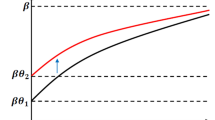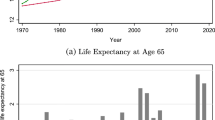Abstract
We analyze in three steps the influence of the projected mortality decline on the long run finances of the Social Security System. First, on a theoretical level, mortality decline adds person years of life which are distributed across the life cycle. The interaction of this distribution with the age distribution of labor earnings minus consumption, or of taxes minus benefits, partially determines the corresponding steady state financial consequences of mortality decline. The effect of mortality decline on population growth rates also matters, but is negligible in low mortality populations. Second, examination of past mortality trends in the United States and of international trends in low mortality populations, suggests that mortality will decline faster than foreseen by the Social Security Administration s forecasts. Third, we combine the work of the first two parts in dynamic simulations to examine the implications of mortality decline and of alternative forecasts of mortality for the finances of the social security system. Also, we use stochastic population forecasts to assess the influence of uncertainty about mortality decline on uncertainty about finances; we find that uncertainty about fertility still has more important implications than uncertainty about mortality, contrary to sensitivity tests in the official forecasts.
Similar content being viewed by others
References
Ahlburg, D. and J. Vaupel. 1990. “Alternative Projections of the U.S. Population.” Demography 27:639–52.
Arthur, W.B. 1981. “The Economics of Risks to Life.” American Economic Review 71:54–64.
Arthur, W.B. and G. McNicoll. 1978. “Samuelson, Population and Intergenerational Transfers.” International Economic Review 19(1):241–46.
Auerbach, A.J., J. Gokhale, and L.J. Kotlikoff. 1991. “Generational Accounts: A Meaningful Alternative to Deficit Accounting.” Pp. 55–110 in Tax Policy and the Economy, edited by D. Bradford. Cambridge: MIT Press for the National Bureau of Economic Research.
Auerbach, A.J. and L.J. Kotlikoff. 1994. “The United States’ Fiscal and Saving Crises and Their Implications for the Baby Boom Generation.” Report to Merrill Lynch & Co.
Board of Trustees, Federal Old-Age and Survivors Insurance and Disability Insurance Trust Funds. 1995. Annual Report of the Board of Trustees of the Federal Old-Age and Survivors Insurance and Disability Insurance Trust Funds. Washington, DC: U.S. Government Printing Office.
Coale, A.J. 1957. “How the Age Distribution of a Human Population Is Determined.” Cold Spring Harbor Symposia in Quantitative Biology 22:83–88. Reprinted, pp. 167–72 in Mathematical Demography, edited by D. Smith and N. Keyfitz. Berlin: Springer-Verlag. (Page citations are to the reprint edition.)
Coale, A.J. and P. Demeny. 1983. Regional Model Life Tables and Stable Populations, second edition. Princeton: Princeton University Press.
Congressional Budget Office. 1996. The Economic and Budget Outlook: Fiscal Years 1997–2006. Washington, DC: U.S. Government Printing Office.
Fries, J.F. 1980. “Aging, Natural Death, and the Compression of Morbidity.” New England Journal of Medicine 303:130–36.
Hamermesh, D.S. 1985. “Expectations, Life Expectancy, and Economic Behav ior.” The Quarterly Journal of Economics 100: 389–408.
Horiuchi, S. and J. Wilmoth. 1995. “Aging of Mortality Decline.” Paper presented at the 1995 Annual Meetings of the Population Association of America, San Francisco.
Kannisto, V., J. Lauritsen, A.R. Thatcher, and I.W. Vaupel. 1994. “Reductions in Mortality at Advanced Ages: Several Decades of Evidence from 27 Countries” Population and Development Review 20:793–810.
Keyfitz, N. 1985a. Applied Mathematical Demography, 2nd edition. New York: Springer-Verlag.
— 1985b. “The Demography of Unfunded Pensions.” European Journal of Population 1:5–30.
Kotlikoff, L. 1981. “Some Economic Implications of Life-Span Extension” Pp. 97–114 in Aging: Biology and Behavior, edited by J. March and J. McGaugh. New York: Academic Press. Reprinted, pp. 358-75 in What Determines Savings? (1989), edited by L. Kot1ikoff. Cambridge: MIT Press.
Lazear, E.P. and R.T. Michael. 1988. Allocation of Income Within the Household. Chicago: University of Chicago Press.
Lee, R. 1990. “Population Policy and Externalities -to Childbearing.” World Population: Approaching the Year 2000 510(Ju1y): 17–32.
— 1994a. “The Formal Demography of Population Aging, Transfers, and the Economic Life Cycle” Pp. 8–49 in The Demography of Aging, edited by L. Martin and S. Preston. Washington, DC: National Academy Press.
— 1994b. “Fertility, Mortality and Intergenerational Transfers: Comparisons Across Steady States” Pp. 135–57 in The Family, the Market and the State in Ageing Societies, edited by J. Ermisch and N. Ogawa. Cambridge: Oxford University Press.
Lee, R. 1996. “Probabilistic Population Forecasting.” Paper presented at meeting at IIASA on population forecasting, Laxenburg, Austria.
Lee, R.D. and L. Carter. 1992. “Modeling and Forecasting the Time Series of U.S. Mortality,” Journal of the American Statistical Association 87(419):659–71.
Lee, R. and J. Skinner. 1996. “Assessing Forecasts of Mortality, Health Status, and Health Costs During Baby-Boomers’ Retirement.” Pp. 195–243 in collection of papers prepared for a workshop of the National Academy of Sciences on Modeling Retirement Income Security for the Baby Boom Generation. National Academy of Sciences.
Lee, R.D. and S. Tuljapurkar. 1994. “Stochastic Population Forecasts for the U.S.: Beyond High, Medium and Low.” Journal of the American Statistical Association 89(428): 1175–89.
Lumsdaine, R.L. and D.A. Wise. 1994. “Aging and Labor Force Participation: A Review of Trends and Explanations” Pp. 7–41 in Aging in the United States and Japan, edited by Y. Noguchi and D. Wise. Chicago: University of Chicago Press.
Manton, K.G., E. Stallard, and RH. Singer. 1994. “Methods for Projecting the Future Size and Health Status of the U.S. Elderly Population” Pp. 41–77 in Studies in the Economics of Aging, edited by D. Wise. Chicago: University of Chicago Press.
Manton, K., E. Stallard, and H.D. Tolley. 1991. “Limits to Human Life Expectancy: Evidence, Prospects, and Implications.” Population and Development Review 17(4):603–38.
Manton, K.G. and J.W. Vaupel. 1995. “Survival After the Age of 80 in the United States, Sweden, France, England and Japan.” The New England Journal of Medicine 333(18): 1232–35.
Olshansky, S.J., B.A. Carnes, and C. Cassel. 1990. “In Search of Methuselah: Estimating the Upper Limits to Human Longevity.” Science 250:634–40.
Poterba, J.M. and L.H. Summers. 1987. “Public Policy Implications of Declining Old-Age Mortality” Pp. 19–51 in Work. Health. and Income Among the Elderly, edited by G. Burtless. Washington, DC: Brookings Institution.
Preston, S. 1996. “American Longevity: Past, Present and Future.” Policy Brief No.7, Center for Policy Research, Maxwell School of Citizenship and Public Affairs, Syracuse University.
Schneider, E.L. and J.M. Guralnik. 1990. “The Aging of America: Impact on Health Care Costs.” Journal of the American Medical Association 263(17):2335–40.
Shoven, J.B., M.D. Topper, and D.A. Wise. 1994. “The Impact of the Demographic Transition on Government Spending” Pp. 13–33 in Studies in the Economics of Aging, edited by D. Wise. Chicago: University of Chicago Press.
Skinner, J. 1985. “The Effect of Increased Longevity on Capital Accumulation” American Economic Review 75: 1143–50.
Social Security Administration, Office of the Actuary, U.S. Department of Health and Human Services. 1992. “Life Tables for the United States Social Security Area 1990-2080.” Actuarial Study No. 107, SSA Pub. No. 11–11536.
Stoto, M.A. and J.S. Durch. 1993. “Forecasting Survival, Health, and Disability: Report on a Workshop.” Population and Development Review 19:557–81.
Tuljapurkar, S. and R.D. Lee. 1996. “Stochastic Forecasts of the Finances of the Social Security System.” Paper presented at the 1996 annual meetings of the Population Association of America, New Orleans.
U.S. Social Security Administration, Office of Research And Statistics. 1994. Social Security Bulletin. Annual Statistical Supplement. Washington DC: U.S. Government Printing Office.
Willis, R. 1988. “Life Cycles, Institutions and Population Growth: A Theory of the Equilibrium Interest Rate in an Overlapping Generations Model” Pp. 106–38 in Economics of Changing Age Distributions in Developed Countries. Cambridge: Oxford University Press.
Wilmoth, J. 1995. “Are Mortality Projections Always More Pessimistic When Disaggregated by Cause of Death?” Mathenatical Population Studies 5(4):293–320.
Author information
Authors and Affiliations
Corresponding author
Additional information
We are grateful to Timothy Miller, Michael Anderson, and Bryan Lincoln for assistance. Two anonymous referees, John Wilmoth, and Kenneth Wachter made helpful comments on an earlier draft. Lee’s research for this paper was funded by Grant AGl176l from the NlA. Tuljapurkar’s research for this paper was funded by a Grant HD32124 from NICHD. Wealso acknowledge support from the University of California-Berkeley’s Center for the Economics and Demography of Aging.
An erratum to this article is available at http://dx.doi.org/10.1007/BF03208771.
Rights and permissions
About this article
Cite this article
Lee, R., Tuljapurkar, S. Death and Taxes: Longer life, consumption, and social security. Demography 34, 67–81 (1997). https://doi.org/10.2307/2061660
Issue Date:
DOI: https://doi.org/10.2307/2061660




